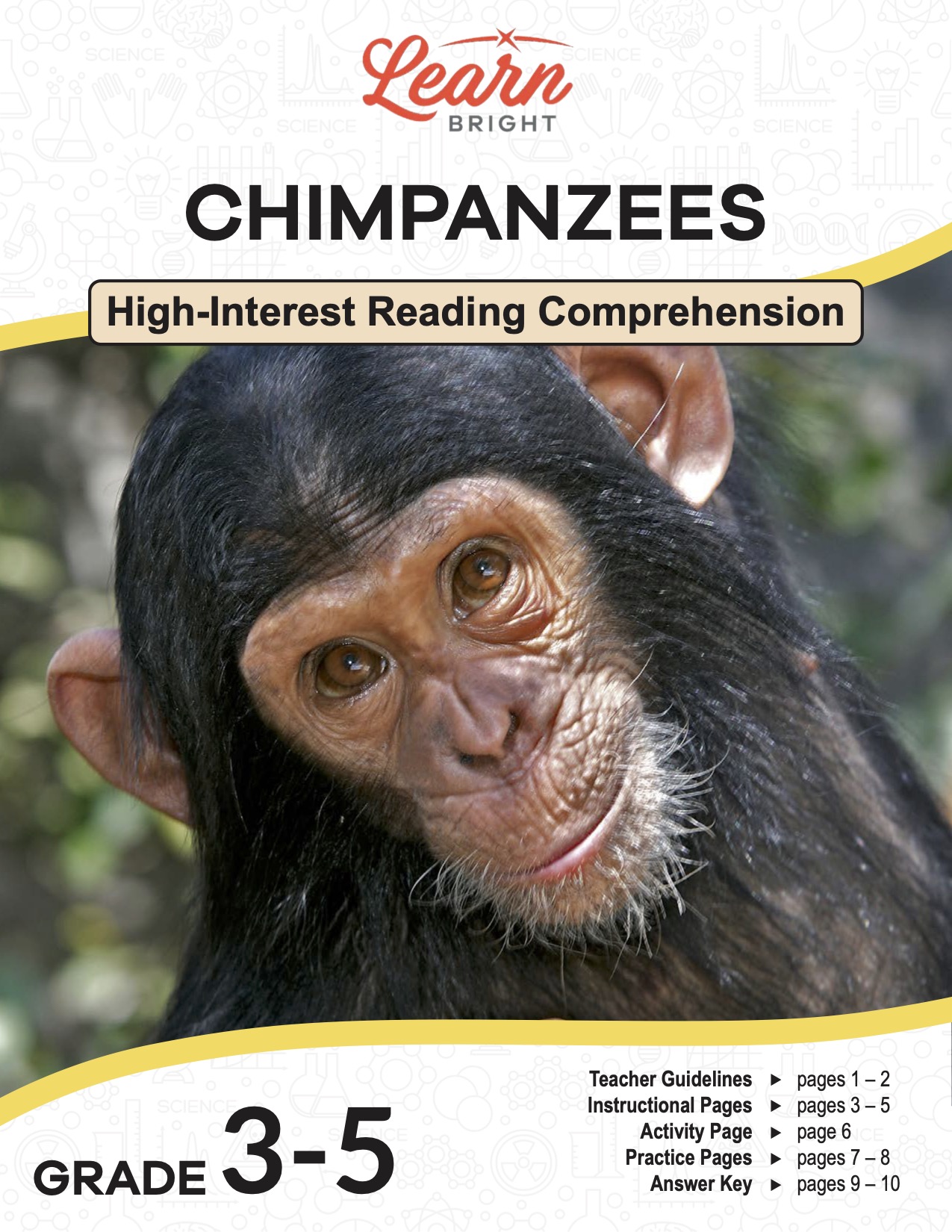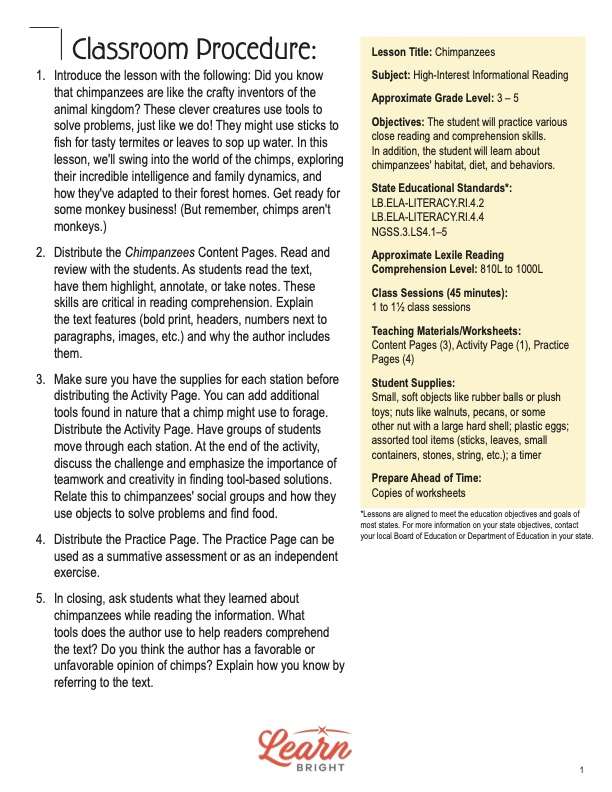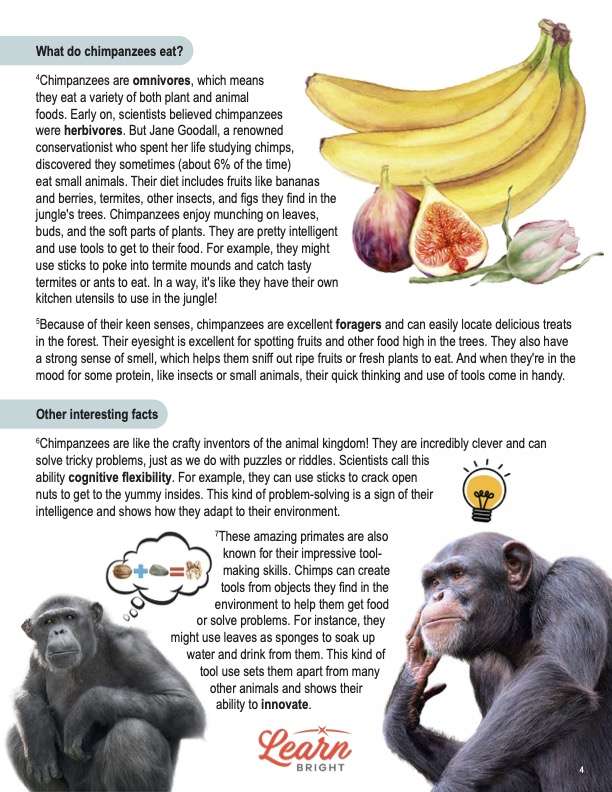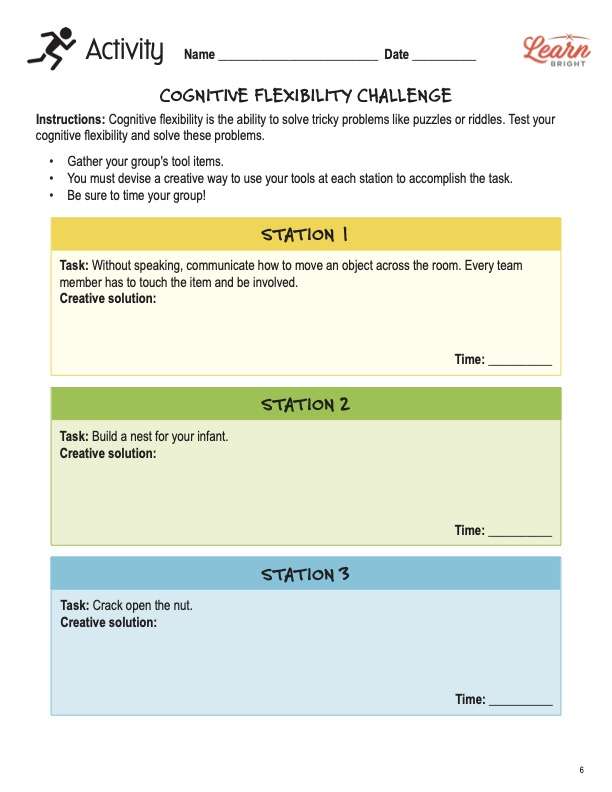Description
What our Chimpanzees lesson plan includes
Lesson Objectives and Overview: Chimpanzees is a high-interest reading comprehension lesson plan. As such, students will practice various close reading and comprehension skills. In addition, they will learn about the chimpanzee’s habitat, diet, and behaviors. This lesson is for students in 3rd grade, 4th grade, and 5th grade.
Classroom Procedure
Every lesson plan provides you with a classroom procedure page that outlines a step-by-step guide to follow. You do not have to follow the guide exactly. The guide helps you organize the lesson and details when to hand out worksheets. It also lists information in the yellow box that you might find useful. You will find the lesson objectives, state standards, and number of class sessions the lesson should take to complete in this area. In addition, it describes the supplies you will need as well as what and how you need to prepare beforehand. The activity for this lesson requires a number of materials, including small, soft objects like rubber balls or plush toys and some nuts like walnuts, pecans, or some other nut with a large hard shell. You will also need plastic eggs, assorted tool items (sticks, leaves, small containers, stones, string, etc.), and a timer.
Teacher Notes
The paragraph on this page provides a little more information or guidance on what to expect from the lesson. It explains that you can teach this lesson in a whole-class setting or as an independent, small-group activity. You can use the blank lines to record any thoughts or ideas you have as you prepare.
CHIMPANZEES LESSON PLAN CONTENT PAGES
What Is a Chimpanzee?
The Chimpanzees lesson plan contains three content pages. It begins by providing a box of background information about this animal. These adorable mammals live in equatorial Africa, which is the area of Africa that surrounds the equator. They enjoy an omnivorous diet, meaning they eat plants and animals. In general, chimps live for between 30 and 40 years.
They have furry bodies covered in hair that can be brown or black. They have big ears and forward-facing eyes, which are excellent for hearing and seeing things in the forest. Chimps have long arms and strong hands that help them swing from tree branches like acrobats. And their feet are kind of like their hands. Chimps can use their feet to grasp things, pick things up like fruits, or just play with each other. These unique features help chimpanzees move around the jungle with ease.
Not surprisingly, chimpanzees are social creatures and like to hang out with other chimps in groups called communities or troops. Troops become like one big, furry family. Inside the troop, there is usually a male leader called an alpha male. He takes care of the others and helps make decisions. In fact, an alpha male is like a captain of a sports team. Members of a troop rely on each other for safety and to find food. They communicate using sounds, gestures, and even facial expressions.
When it comes to family, chimpanzees are excellent parents! They treat their young ones, called infants, with care and love. Baby chimpanzees stay close to their moms and hold on to their fur when they need a ride. Moms make cozy nests for them to sleep in at night. Like human babies and children, young chimpanzees learn essential things from their parents and the other troop members. This includes finding food, using tools, and being safe in the jungle.
Diet of a Chimp
Remember, chimpanzees are omnivores, which means they eat a variety of both plant and animal foods. Early on, scientists believed chimpanzees were herbivores. But Jane Goodall, a renowned conservationist who spent her life studying chimps, discovered they sometimes (about 6% of the time) eat small animals. Their diet includes fruits like bananas and berries, termites, other insects, and figs they find in the jungle’s trees.
Chimpanzees enjoy munching on leaves, buds, and the soft parts of plants. They are pretty intelligent and use tools to get to their food. For example, they might use sticks to poke into termite mounds and catch tasty termites or ants to eat. In a way, it’s like they have their own kitchen utensils to use in the jungle!
Because of their keen senses, chimpanzees are excellent foragers and can easily locate delicious treats in the forest. Their eyesight is excellent for spotting fruits and other food high in the trees. They also have a strong sense of smell, which helps them sniff out ripe fruits or fresh plants to eat. And when they’re in the mood for some protein, like insects or small animals, their quick thinking and use of tools come in handy.
More Interesting Facts
Chimpanzees are like the crafty inventors of the animal kingdom! They are incredibly clever and can solve tricky problems, just as we do with puzzles or riddles. Scientists call this ability cognitive flexibility. For example, they can use sticks to crack open nuts to get to the yummy insides. This kind of problem-solving is a sign of their intelligence and shows how they adapt to their environment.
These amazing primates are also known for their impressive tool- making skills. Chimps can create tools from objects they find in the environment to help them get food or solve problems. For instance, they might use leaves as sponges to soak up water and drink from them. This kind of tool use sets them apart from many other animals and shows their ability to innovate.
Believe it or not, chimpanzees even have their own language! They communicate with each other using a combination of vocalizations, body movements, and facial expressions. They can make sounds to convey emotions like happiness, fear, or excitement. Scientists discovered that chimps use gestures, like waving or clapping their hands, to tell each other what they want or to share their feelings. This shows how complex and sophisticated their social interactions can be.
Why Are Chimpanzees Important to the Environment?
Chimpanzees are vital for the environment because they play a crucial role in helping forests grow and stay healthy. They are seed dispersers—they eat fruits and then scatter the seeds in different places through their droppings. These seeds grow into new trees and plants, which is fantastic for the forest. Healthy forests, in turn, provide homes for many other animals, clean the air we breathe, and even help regulate the climate.
Sadly, chimps are currently endangered. One of the biggest reasons for this is habitat loss. The forests where they live are being cut down for things like logging and farming, which takes away their homes. Additionally, some chimpanzees face threats from poaching, which is when people hunt them for their body parts or capture them to sell as pets. Conservation efforts are essential to protecting these amazing animals and their forest homes. By learning about chimpanzees and their importance, we can help raise awareness and work together to ensure their survival.
CHIMPANZEES LESSON PLAN WORKSHEETS
The Chimpanzees lesson plan includes two worksheets: an activity worksheet and a practice worksheet. Each one will help students solidify their grasp of the material they learned throughout the lesson. You can refer to the classroom procedure guidelines to know when to hand out each worksheet.
COGNITIVE FLEXIBILITY CHALLENGE ACTIVITY WORKSHEET
For the activity, students will have to do a series of challenges to test their cognitive flexibility. This is the ability to solve tricky problems, like puzzles or riddles. Students will be in groups as they complete the tasks. Each station has a set of tools and other materials students can use to complete the task.
At the first station, they must communicate without speaking how to move an object across the room. Each team member has to touch the item and be involved. At the second station, students will build a nest for their infant. The last station requires them to crack open the nut. Students will write how long each task took and what their creative solution was to each problem.
CHIMPANZEES REVIEW PRACTICE WORKSHEET
The practice worksheet requires students to answer a series of 11 questions. These questions all relate to the content pages, so students will need to refer to them often for the answers. In addition, each question provides which reading tool the question corresponds to, such as text feature, vocabulary, or comprehension.
Worksheet Answer Keys
At the end of the lesson plan document is an answer key for the practice worksheet. The correct answers are all in red to make it easier for you to compare them with students’ responses. If you choose to administer the lesson pages to your students via PDF, you will need to save a new file that omits these pages. Otherwise, you can simply print out the applicable pages and keep these as reference for yourself when grading assignments.










